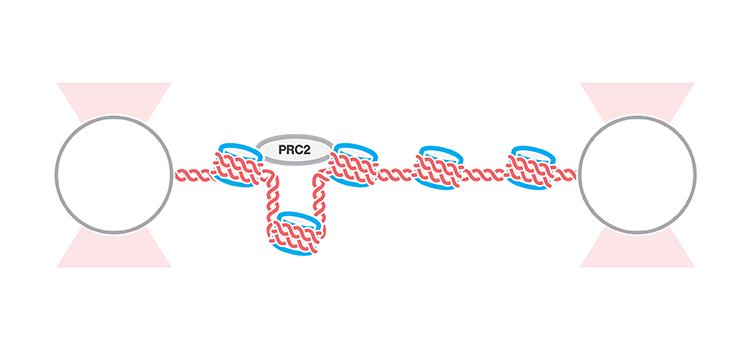A recent study published in PNAS used single-molecule force spectroscopy to examine unknown interaction mechanisms between polycomb repressive complex 2 (PRC2) and chromatin. The authors evaluated arrays of multiple nucleosomes using their C-Trap® optical tweezers system and identified distal nucleosome bridging by PRC2.
The findings provide a better understanding of the molecular characteristics underlying epigenetic regulation by PRC2 and suggest alternative mechanisms behind epigenetic memory and stability. They also offer insight into the influence of accessory proteins AEBP2 and JARID2, as well as the H3K27 trimethylation (H3K27me3) profile, on PRC2 binding and activity.
To study the interactions between PRC2 and nucleosomes, Leicher et al. first assembled a DNA template containing repeats of 12 nucleosomes, separated by linker DNA (30 base pairs). Single arrays were then tethered to optically trapped beads to stretch the constructs and measure the DNA unwrapping in the presence or absence of PRC2.
The researchers found that pulling the trapped construct resulted in different types of transitions, reflecting the unwrapping of single nucleosomes. Interestingly, apart from identifying known PRC2 binding modes, such as on bare DNA or single nucleosomes, they observed that the complex also bridged nucleosomes separated by spacer nucleosomes. In particular, a bridging profile with one spacer nucleosome (see featured figure) appeared to be the preferred interaction mode compared with other distal-bridging profiles.
The distal interactions were also observed to establish highly stable links between nucleosomes, suggesting that PRC2 can mediate chromatin compaction. These findings also highlight properties by which PRC2 spreads its repressive H3K27me3 mark.
“These long-range contacts have significant implications for the mechanism of H3K27me3 spreading,” the authors concluded. “It argues against models in which PRC2 propagates H3K27me3 along nucleosome arrays in strictly linear progression.”
Read the full article titled “Single-molecule and in silico dissection of the interaction between Polycomb repressive complex 2 and chromatin” on PNAS to find out more about these findings.
Are you interested in using dynamic single-molecule tools like the C-Trap® Optical Tweezers – Fluorescence & Label-free Microscopy systems for your research? Feel free to contact us for more information, a demo, or a quote.



